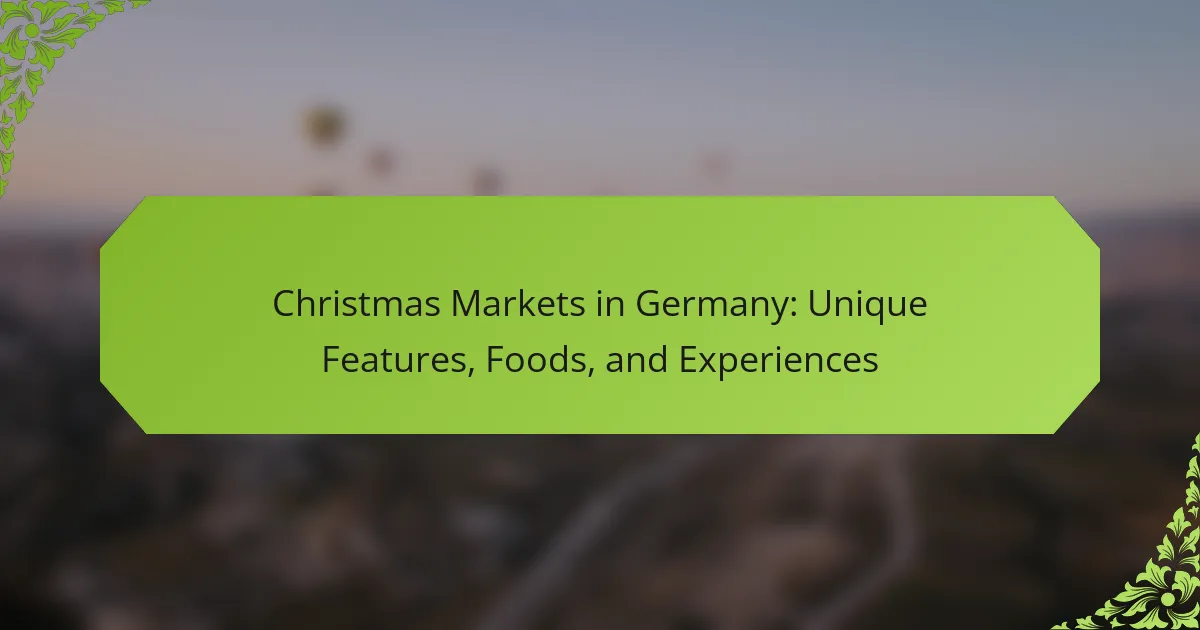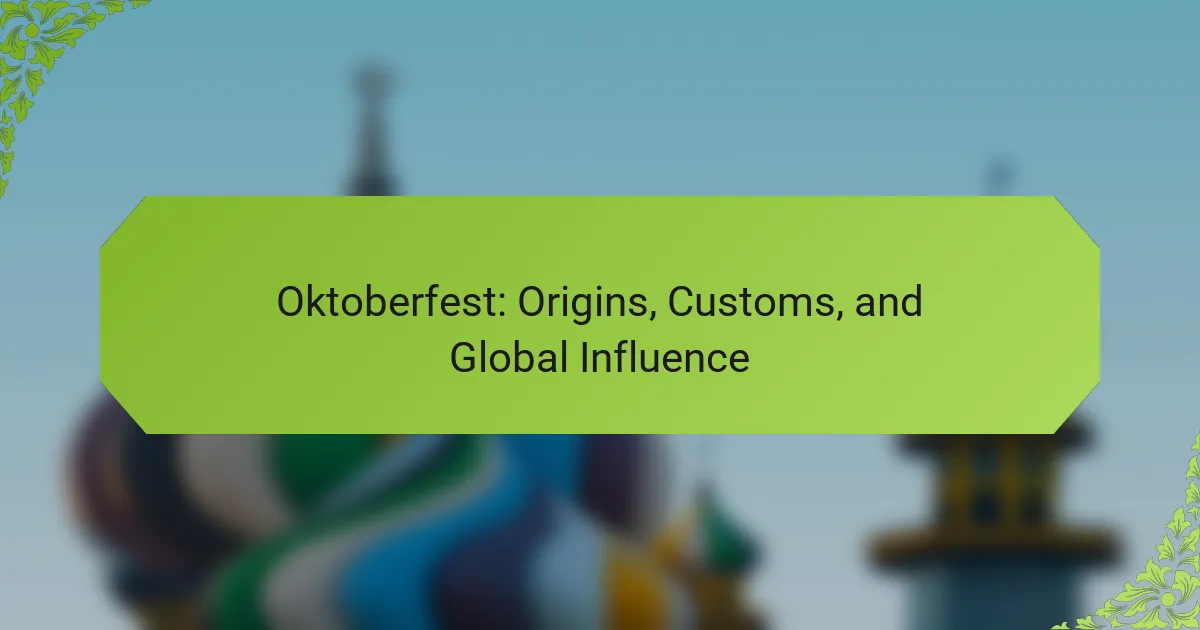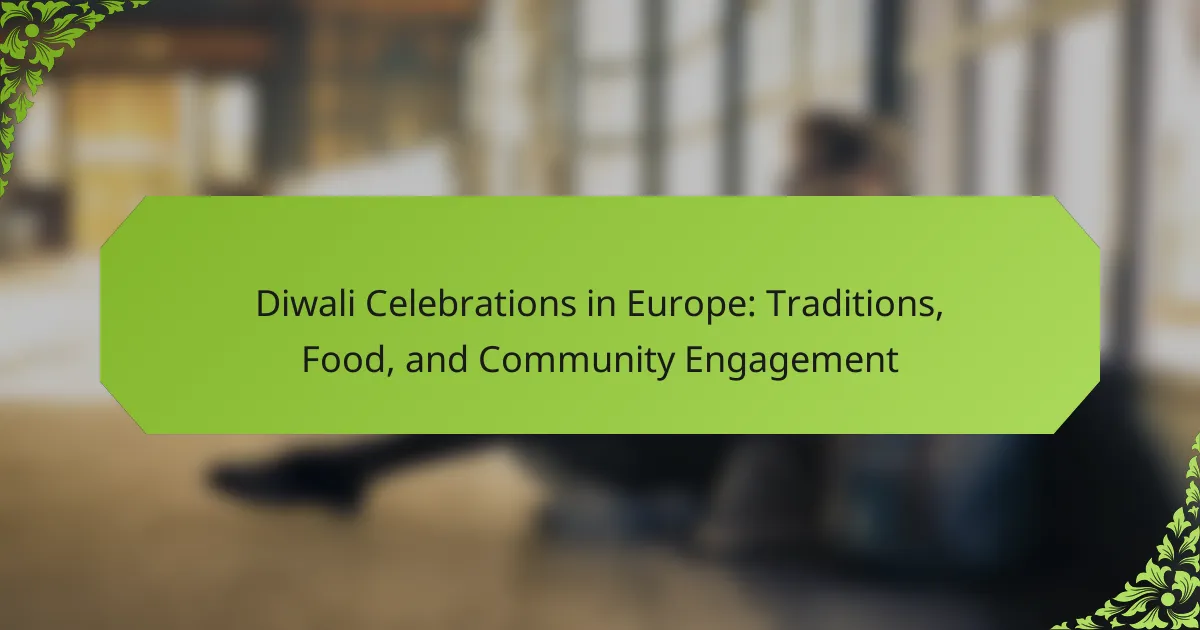Experience the enchanting atmosphere of Christmas markets in Germany, where festive lights, traditional foods, and unique crafts come together. Discover must-try delicacies like bratwurst, lebkuchen, and glühwein. Explore local cultural events and artisan demonstrations that reflect regional customs. Learn about the economic impact of these markets and their growing trend towards sustainability.

What makes Christmas markets in Germany unique?
Christmas markets in Germany are unique due to their festive atmosphere, traditional foods, and handcrafted goods. These markets, often held in historic town squares, feature beautifully decorated stalls offering mulled wine, gingerbread, and roasted chestnuts. Visitors experience local culture through live music, performances, and artisanal crafts. Each market has its distinct charm, with some showcasing regional specialties, making them a seasonal highlight for both locals and tourists. The blend of history, community, and culinary delights creates an unforgettable experience.
How do local traditions influence market designs?
Local traditions significantly shape the design of Christmas markets in Germany. Each market reflects regional customs, showcasing unique architectural styles, decorations, and layouts that resonate with local heritage.
For example, Nuremberg’s Christkindlesmarkt features a traditional wooden stall design, while Dresden’s Striezelmarkt emphasizes historical elements linked to its long-standing heritage. Local culinary specialties, such as Lebkuchen in Nuremberg and Stollen in Dresden, further enhance the market experience by connecting visitors to regional flavors.
Moreover, festivals often incorporate local music and performances, creating an immersive atmosphere that celebrates community spirit. This blend of tradition and modern market trends fosters a unique cultural exchange, drawing both locals and tourists to experience the festive charm.
Which cities are renowned for their Christmas markets?
Nuremberg, Munich, and Dresden are renowned for their Christmas markets. These cities feature unique decorations, traditional foods, and festive experiences that attract visitors annually.
Nuremberg’s Christkindlesmarkt is famous for its handcrafted goods and gingerbread. Munich’s market offers a blend of local delicacies and cultural performances. Dresden’s Striezelmarkt, one of Germany’s oldest, showcases a rich history and a variety of festive treats.
Each market provides a unique atmosphere, making them must-visit destinations during the holiday season.
What are the typical opening times and duration of these markets?
Christmas markets in Germany typically open in late November and run until Christmas Eve, with some extending into early January. Opening times vary, but most markets operate daily from around 10 AM to 9 PM. Some may have reduced hours on Christmas Eve.
How do Christmas markets differ across regions in Germany?
Christmas markets in Germany vary significantly by region, showcasing distinct local traditions and offerings. Northern markets, like those in Hamburg, emphasize maritime themes and fish dishes. In contrast, southern markets, such as those in Munich, highlight Bavarian crafts and hearty foods like pretzels and sausages.
Central Germany, particularly in cities like Dresden, features elaborate decorations and unique sweets like Stollen. Each region also presents different atmospheres, from the bustling crowds in urban centers to the quaint charm of smaller towns.
Local specialties often reflect regional ingredients, enhancing the overall experience. For example, the use of spices in Glühwein varies, with some areas favoring cinnamon while others lean towards star anise.
Overall, the diversity of Christmas markets across Germany enriches the holiday experience, offering visitors a taste of local culture and culinary delights.
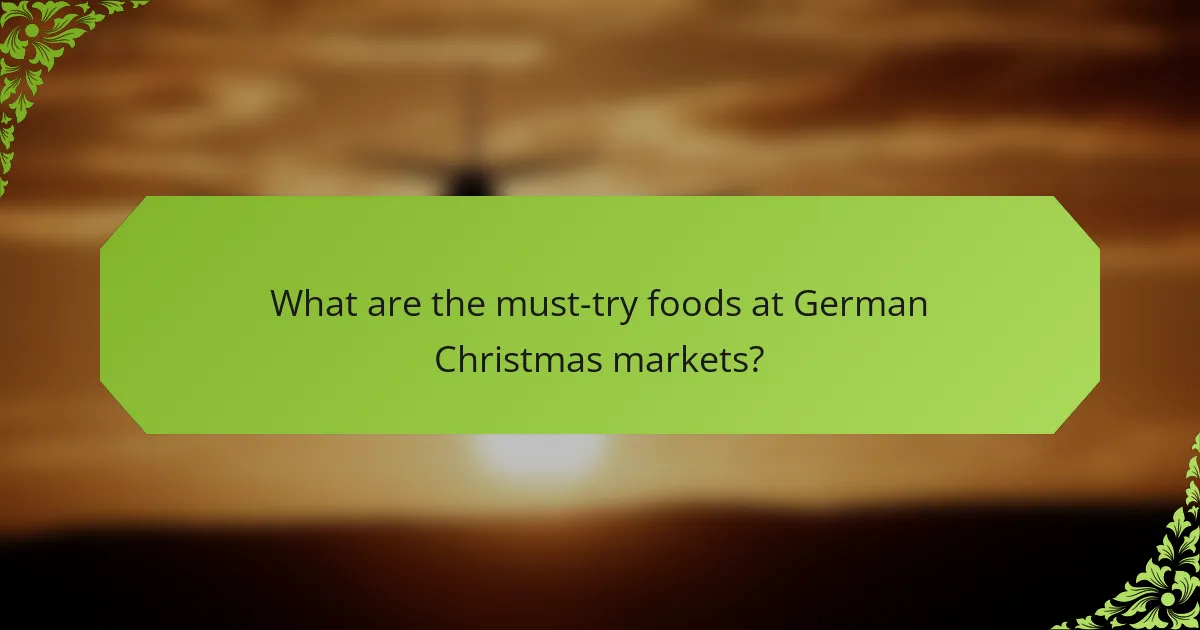
What are the must-try foods at German Christmas markets?
The must-try foods at German Christmas markets include bratwurst, lebkuchen, and glühwein. These traditional delights offer a taste of festive culture.
Bratwurst is a grilled sausage, often served with mustard and bread. Lebkuchen are spiced gingerbread cookies available in various shapes and sizes. Glühwein is a warm mulled wine infused with spices, perfect for cold weather.
Other notable foods are roasted chestnuts, potato pancakes, and stollen, a fruit bread rich in flavor. Each market showcases unique regional specialties, enhancing the overall experience.
Which traditional dishes are popular among visitors?
Popular traditional dishes among visitors at Christmas markets in Germany include bratwurst, stollen, and glühwein. These foods offer a taste of local culture and festive spirit. Bratwurst is a grilled sausage often served with mustard. Stollen is a rich fruit bread, typically dusted with powdered sugar. Glühwein is a spiced mulled wine, perfect for warming up in cold weather. Other favorites include lebkuchen, a type of gingerbread, and roasted chestnuts, which add to the festive atmosphere.
How do seasonal beverages enhance the market experience?
Seasonal beverages significantly enhance the market experience by creating a festive atmosphere and attracting visitors. These drinks, such as mulled wine and spiced cider, evoke seasonal nostalgia and encourage social interactions. Unique flavors and presentations differentiate them from standard offerings, making them memorable. Additionally, seasonal beverages often reflect regional traditions, adding cultural depth to the market experience. This combination of sensory appeal and cultural significance increases foot traffic and customer satisfaction.
What unique food items can be found at specific markets?
Christmas markets in Germany feature unique food items that reflect local traditions. Popular offerings include bratwurst, roasted chestnuts, and stollen.
Specific markets showcase distinct specialties. For example, the Nuremberg Christkindlesmarkt is famous for its Nuremberg gingerbread, while the Dresden Striezelmarkt highlights the rich fruitcake known as Stollen.
Additionally, some markets offer rare delights such as potato pancakes in Berlin or mulled wine variations in Cologne. These unique food items enhance the festive atmosphere and provide a taste of regional culinary heritage.

What experiences can visitors expect at German Christmas markets?
Visitors can expect a magical atmosphere filled with festive lights, traditional foods, and unique crafts at German Christmas markets. These markets offer an array of experiences that capture the essence of the holiday season.
Local delicacies such as bratwurst, pretzels, and mulled wine are staples, drawing crowds eager to savor authentic flavors. The markets also feature handcrafted ornaments and gifts, showcasing regional artisanship.
Entertainment is abundant, with live music, carolers, and sometimes even theatrical performances, enhancing the festive spirit. Families can enjoy activities like ice skating and visiting Santa Claus, making it a memorable outing for all ages.
Each market has its unique charm, often reflecting local traditions and customs, creating a distinctive experience in every city. Visitors leave with not only souvenirs but also cherished memories of the holiday season in Germany.
How do entertainment and activities vary by location?
Christmas markets in Germany vary significantly by location, showcasing unique features, foods, and experiences. Each region highlights local traditions, crafts, and culinary specialties, creating distinct atmospheres. For example, Nuremberg’s Christkindlesmarkt is famous for its gingerbread, while Dresden’s Striezelmarkt is known for its fruitcake. Additionally, markets in Cologne feature a vibrant mix of handmade goods and mulled wine, reflecting the city’s festive spirit. The diversity in offerings enhances the overall experience, making each market visit unique.
What role do crafts and local artisans play in the markets?
Crafts and local artisans play a vital role in Christmas markets in Germany by providing unique, handmade goods. Their products often reflect regional traditions and cultural heritage, enhancing the market’s authenticity. Artisans contribute to the festive atmosphere through live demonstrations, showcasing skills in woodworking, pottery, and textile arts. This engagement fosters community connections and supports local economies. Unique items, such as handcrafted ornaments and artisanal foods, attract visitors seeking distinctive gifts and experiences. As a result, these markets become vibrant hubs of creativity and local craftsmanship.
Which family-friendly attractions are available?
Germany’s Christmas markets offer a variety of family-friendly attractions. These include festive activities such as ice skating, carousel rides, and workshops for children. Unique features like traditional crafts and live performances enhance the experience. Families can enjoy diverse foods, including roasted chestnuts and gingerbread, making the markets a delightful outing for all ages.

How do Christmas markets contribute to local economies?
Christmas markets significantly boost local economies by attracting tourists and increasing sales for vendors. These festive events generate revenue through food, crafts, and entertainment, creating seasonal job opportunities. In Germany, markets can draw millions of visitors, leading to an estimated economic impact of over 1 billion euros annually. Additionally, they promote local culture and craftsmanship, enhancing community identity and cohesion.
What economic benefits do markets bring to host cities?
Christmas markets in Germany provide significant economic benefits to host cities. They attract tourists, boost local businesses, and create seasonal employment opportunities.
These markets generate increased revenue through food, crafts, and entertainment sales. For example, a single market can bring in millions in sales, significantly impacting the local economy.
Additionally, Christmas markets enhance the city’s visibility, promoting future tourism. They foster community engagement and cultural exchange, enriching the local identity.
Overall, the economic benefits of Christmas markets are substantial, making them vital to the host cities’ financial health and cultural landscape.
How do small businesses thrive during the holiday season?
Small businesses can thrive during the holiday season by leveraging Christmas markets in Germany. These markets offer unique features, such as festive decorations, traditional crafts, and a vibrant atmosphere that attracts large crowds.
Local foods, including roasted chestnuts, mulled wine, and gingerbread, draw in visitors and create memorable experiences. The appeal of these markets fosters community engagement and encourages shoppers to support local vendors.
Additionally, businesses can enhance their visibility by participating in these markets, which often have high foot traffic. This platform allows small businesses to showcase their products, connect with customers, and build brand loyalty during the competitive holiday season.

What are the environmental impacts of Christmas markets?
Christmas markets can have significant environmental impacts, including waste generation and increased carbon emissions. The popularity of these markets leads to higher consumption of resources, such as energy for lighting and heating. Additionally, food waste is common due to unsold products.
Local ecosystems may be affected by increased foot traffic and infrastructure development. Market setups can disrupt habitats and contribute to pollution. However, many markets are adopting sustainable practices, such as using biodegradable materials and promoting local artisans, to mitigate these impacts.
As a result, while Christmas markets can negatively impact the environment, there is a growing trend towards sustainability that aims to reduce their ecological footprint.
How are sustainability practices being integrated into market operations?
Sustainability practices are increasingly integrated into German Christmas markets through eco-friendly initiatives. Many markets prioritize local vendors, reducing transportation emissions while supporting regional economies. Waste management strategies, such as recycling and composting, are implemented to minimize environmental impact. Additionally, some markets offer biodegradable products and promote sustainable food options, enhancing the overall experience while fostering environmental responsibility.
What challenges do markets face regarding waste management?
Christmas markets in Germany face various challenges regarding waste management. Key issues include high visitor numbers leading to increased waste generation, inadequate recycling facilities, and the need for sustainable practices.
The festive atmosphere often results in the use of single-use plastics, creating significant environmental concerns. As a result, market organizers must implement effective waste reduction strategies and promote eco-friendly alternatives to minimize their ecological footprint.
Collaboration with local authorities and waste management companies is essential to enhance recycling efforts and ensure proper waste disposal. Education and awareness campaigns can further encourage visitors to participate in sustainable practices, ultimately benefiting both the environment and the market experience.
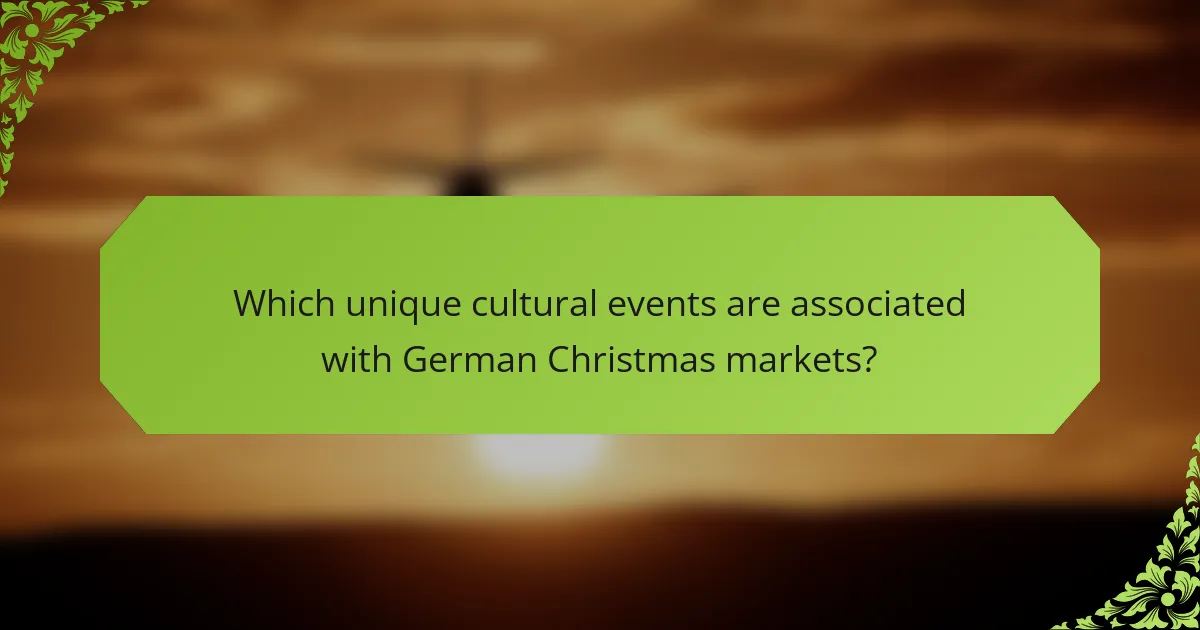
Which unique cultural events are associated with German Christmas markets?
German Christmas markets feature unique cultural events such as festive parades, traditional music performances, and artisan craft demonstrations. These events showcase regional customs and foster community spirit. For example, in Nuremberg, the Christkindlesmarkt features a ceremonial opening by the Christkind, a traditional gift-bringer. Additionally, many markets host live nativity scenes, enhancing the holiday atmosphere. Visitors can experience local traditions through food tastings and cultural workshops, making each market a distinctive celebration of German heritage.
How do local festivals enhance the market atmosphere?
Local festivals, such as Christmas markets in Germany, significantly enhance market atmosphere by fostering community engagement and creating a festive environment. These markets feature unique handcrafted goods, traditional foods, and cultural experiences that attract both locals and tourists. The vibrant decorations and seasonal music contribute to an inviting ambiance, encouraging social interactions and boosting local economies. Additionally, the opportunity to experience regional specialties, like mulled wine and gingerbread, adds to the overall appeal, making these festivals a vital part of the holiday season.
What are the most notable performances or shows featured?
Germany’s Christmas markets showcase remarkable performances, including live music, theatrical shows, and traditional dance. Popular events feature local choirs singing carols, puppet shows for children, and performances by regional artists. Each market offers unique cultural experiences, enhancing the festive atmosphere. Notable performances often highlight traditional German folklore, contributing to the markets’ charm and appeal.

What are the best practices for visiting Christmas markets?
To enjoy Christmas markets in Germany, plan your visit during evenings for a magical atmosphere. Arrive early to avoid crowds and savor local foods like bratwurst and mulled wine. Dress warmly, as temperatures can drop significantly. Explore different stalls for unique handcrafted gifts and decorations. Engage with local traditions to enhance your experience.
How can visitors make the most of their market experience?
Visitors can enhance their market experience by engaging with local vendors, sampling authentic foods, and participating in festive activities. Exploring various stalls allows for discovering unique handcrafted items and seasonal treats. Attending live performances and workshops provides cultural insights and memorable interactions. Arriving early helps avoid crowds and ensures a leisurely experience. Embracing the festive atmosphere and mingling with locals enriches the overall enjoyment of Christmas markets in Germany.
What common mistakes should visitors avoid?
Visitors should avoid common mistakes to fully enjoy Christmas markets in Germany. First, don’t underestimate the cold; dress warmly. Second, plan your visit ahead of time to experience specific events. Third, be cautious with cash, as some vendors may not accept cards. Fourth, avoid peak hours to enjoy a more relaxed atmosphere. Lastly, don’t miss local specialties; try regional foods and drinks to enhance your experience.
